Correct Answer

verified
Correct Answer
verified
Essay
What is the major organic product obtained from the following reaction? 
Correct Answer

verified
Correct Answer
verified
Essay
What is the major organic product obtained from the following reaction? 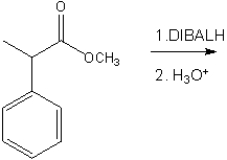
Correct Answer

verified
Correct Answer
verified
Multiple Choice
What is the major organic product of the following sequence of reactions? 
A) 1
B) 2
C) 3
D) 4
F) B) and C)
Correct Answer

verified
Correct Answer
verified
Multiple Choice
What is the major organic product obtained from the following reaction? 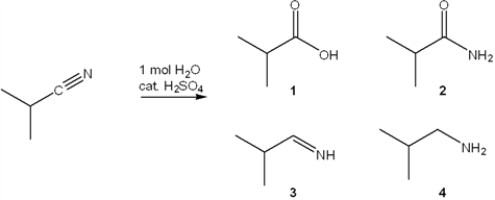
A) 1
B) 2
C) 3
D) 4
F) A) and B)
Correct Answer

verified
Correct Answer
verified
True/False
The product of the following reaction would be classified as a carboxylic acid. 
B) False
Correct Answer

verified
Correct Answer
verified
True/False
Of the following substances, the first and last substance shown are not derivatives of carboxylic acids. 
B) False
Correct Answer

verified
Correct Answer
verified
Essay
What is the major organic product obtained from the following reaction? 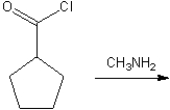
Correct Answer

verified
Correct Answer
verified
Multiple Choice
What is "X" in the following reaction? 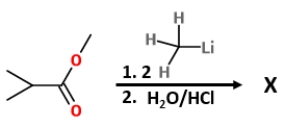
A) ![]()
B) ![]()
C) ![]()
D) ![]()
F) None of the above
Correct Answer

verified
Correct Answer
verified
Multiple Choice
What is the major organic product obtained from the following reaction? 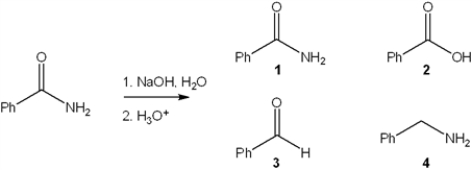
A) 1
B) 2
C) 3
D) 4
F) B) and C)
Correct Answer

verified
Correct Answer
verified
Multiple Choice
What is the major organic product obtained from the following reaction? 
A) 1
B) 2
C) 3
D) 4
F) A) and B)
Correct Answer

verified
Correct Answer
verified
Multiple Choice
What of the following is the correct assignment of the classes of the following compounds? 
A) 1 = lactone; 2 = ester; 3 = amide
B) 1 = ester; 2 = ester; 3 = imide
C) 1 = ester; 2 = imide; 3 = amide
D) 1 = lactone; 2 = anhydride; 3 = imide
F) A) and C)
Correct Answer

verified
Correct Answer
verified
Essay
What is the major organic product obtained from the following reaction? 
Correct Answer

verified
Correct Answer
verified
Short Answer
Consider the following spectrum of a carboxylic acid derivative. 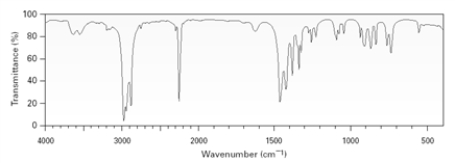 This spectrum indicates the presence of a ___________group.
This spectrum indicates the presence of a ___________group.
Correct Answer

verified
Correct Answer
verified
Multiple Choice
What is the major organic product of the following sequence of reactions? 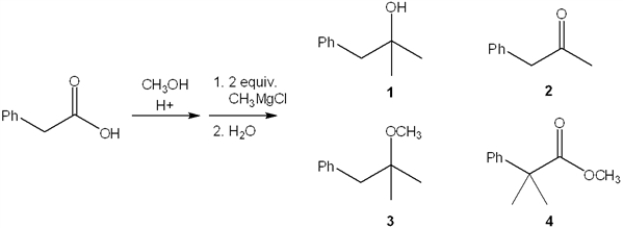
A) 1
B) 2
C) 3
D) 4
F) A) and D)
Correct Answer

verified
Correct Answer
verified
Multiple Choice
Which of the following compounds is a 3° amide? 
A) 1
B) 2
C) 3
D) 4
F) A) and C)
Correct Answer

verified
Correct Answer
verified
Multiple Choice
What is the major organic product obtained from the following reaction? 
A) 1
B) 2
C) 3
D) 4
F) C) and D)
Correct Answer

verified
Correct Answer
verified
Multiple Choice
Which of the following compounds is a 2° amide? 
A) 1
B) 2
C) 3
D) 4
F) A) and C)
Correct Answer

verified
Correct Answer
verified
Multiple Choice
Carboxylate anions are inert to nucleophilic acyl substitution because --_____.
A) carboxylate anions are negatively charged and therefore repel nucleophiles
B) carboxylate anions are resonance stabilized and therefore become neutral
C) carboxylate ions are positively charged and therefore repel nucleophiles
D) carboxylate anions are negatively charged and therefore attract nucleophiles
F) A) and D)
Correct Answer

verified
Correct Answer
verified
Multiple Choice
What is the major organic product obtained from the following reaction? 
A) 1
B) 2
C) 3
D) 4
F) None of the above
Correct Answer

verified
Correct Answer
verified
Showing 61 - 80 of 117
Related Exams